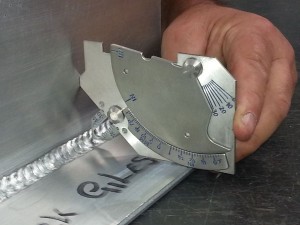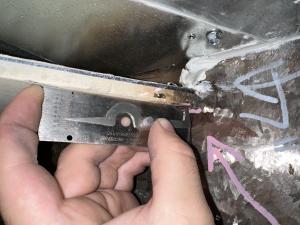How Welding Inspection Gilbert Arizona Can Boost Your Building And Construction and Production Processes
Exploring the Relevance of Welding Evaluation in Industrial Applications: Guarding Against Failings and Enhancing Long Life
Welding assessment acts as a vital line of protection in commercial applications, making certain the structural stability and integrity of welded elements. By methodically identifying problems such as porosity and insufficient fusion, evaluations not just prevent failures however additionally extend the lifespan of necessary properties. Complying with market requirements boosts both safety and operational effectiveness; nevertheless, the effects of disregarding these practices can be serious. As we take a look at the complex advantages of regular inspections, it ends up being obvious that recognizing these characteristics is not just a matter of compliance but a tactical critical for longevity and risk mitigation.
Role of Welding Assessment
Welding evaluation serves as a vital protect in industrial applications, ensuring that bonded frameworks meet specified criteria of high quality and safety. This process entails a methodical evaluation of welds to validate their honesty, strength, and conformity with well established codes and specs. The role of welding examination is diverse, encompassing both aesthetic evaluations and non-destructive screening techniques, which may consist of ultrasonic, radiographic, or magnetic bit screening.
Efficient welding inspection recognizes potential concerns early, reducing the threat of disastrous failures that can develop from inadequate welds. By making certain that welds are performed according to design specs, assessors add to the overall architectural reliability and long life of components in important applications, such as pressure vessels, pipes, and architectural frameworks.

Usual Welding Issues

Among one of the most widespread issues is porosity, identified by little gas pockets caught within the weld metal. This occurs due to impurities or inappropriate securing gas, jeopardizing the weld's stamina. Another substantial issue is insufficient combination, where the weld metal falls short to bond effectively with the base product, potentially leading to architectural weaknesses.

Cracks can additionally establish during or after the welding procedure, typically credited to thermal stresses or inappropriate cooling prices. Additionally, damaging, where the base metal is deteriorated along the weld bead, can weaken the joint and is usually triggered by excessive warm input or incorrect strategy.
Moreover, absence of penetration takes place when the weld steel does not reach the origin of the joint, leading to poor strength. Recognizing these common flaws is essential for examiners and welders alike to make certain that welded frameworks fulfill security and efficiency standards, eventually preventing prospective failings in industrial applications.
Benefits of Routine Evaluations
Normal inspections work as a critical protect in making certain the reliability and durability of bonded frameworks. These evaluations identify prospective issues and weak points that may jeopardize the stability of welds, permitting timely remediation before problems intensify. By applying a structured inspection routine, organizations can substantially lower the risk of devastating failings that might lead to costly downtime, devices substitute, and even crashes.
Additionally, normal examinations add to boosted quality control throughout the welding process. By adhering to a consistent evaluation routine, business can make sure that their welding methods satisfy recognized high quality criteria and best practices. This not only cultivates a society of liability yet likewise motivates continuous improvement amongst welding employees.
Furthermore, routine evaluations help with better upkeep preparation. By determining deterioration early, organizations can purposefully set up replacements and fixings, lessening interruption to operations. This aggressive technique eventually results in extended property life expectancy and improved total efficiency.
Finally, a commitment to normal inspections can improve a company's track record in the industry. Customers and stakeholders progressively worth organizations that focus on safety and high quality, therefore improving trust fund and potentially causing increased service possibilities.
Industry Specifications and Rules
Abiding by market criteria and regulations is an essential facet of welding inspection that matches the advantages of normal assessments. These requirements, developed by companies such as the American Welding Society (AWS) and the American Society of Mechanical Engineers (ASME), give a framework for best methods in welding procedures, products, and inspection methods. Conformity with these regulations guarantees that welds satisfy the needed top quality and safety and security benchmarks, substantially lowering the risk of structural failures.
Regulative bodies like the Occupational Security and Health And Wellness Management (OSHA) additionally apply standards that shield employees and the environment during welding operations. By following these established standards, markets can enhance the dependability of their structures and elements, ensuring they carry out as planned under numerous operational conditions.
Additionally, see here adherence to industry standards fosters uniformity in top quality control, promoting smoother interaction amongst stakeholders and regulative firms. This alignment not just decreases responsibility dangers however also enhances the reliability of organizations in affordable markets. Welding Inspection Gilbert Arizona. Eventually, compliance with welding standards and laws is not simply a legal obligation; it is an essential financial investment in security, efficiency, and lasting operational success
Future Trends in Welding Inspection
As sectors Go Here remain to evolve, the future of welding examination is poised to incorporate sophisticated technologies that boost accuracy and performance. One of the most considerable trends is the fostering of automation and robotics in examination processes. Automated systems can conduct examinations quickly, reducing human mistake and increasing throughput in making environments.
In addition, the combination of expert system (AI) and artificial intelligence formulas will make it possible for predictive analytics, enabling for real-time analyses and aggressive maintenance. By examining information from previous evaluations, these modern technologies can identify patterns that might show potential failures, therefore extending the life expectancy of bonded parts.
Additionally, non-destructive screening (NDT) methods are expected to come to be more advanced, using devices such as drones and independent automobiles furnished with cutting-edge sensors. Welding Inspection Gilbert Arizona. These improvements will enhance the capability to evaluate hard-to-reach or hazardous locations without endangering safety and security
Additionally, the trend towards digitalization will result in enhanced information management systems that facilitate far better tracking, reporting, and conformity with industry requirements. In summary, the future of welding inspection is defined by technical advancements that promise to considerably enhance dependability, security, and operational efficiency in various industrial applications.
Conclusion
In verdict, welding assessment serves a crucial function in making certain the integrity and durability of Learn More Here welded frameworks across numerous industrial applications. As innovations in innovation proceed to develop, the future of welding examination guarantees increased accuracy and performance, eventually adding to the longevity of vital infrastructures.
Welding assessment serves as an essential line of defense in commercial applications, ensuring the structural honesty and reliability of bonded parts.Welding evaluation offers as a critical protect in commercial applications, making sure that welded frameworks fulfill specified requirements of top quality and safety. Ultimately, the role of welding assessment is essential in promoting safety and security, boosting efficiency, and securing financial investments in commercial infrastructure.
These standards, established by companies such as the American Welding Culture (AWS) and the American Culture of Mechanical Designers (ASME), give a structure for best techniques in welding processes, materials, and evaluation methods.In final thought, welding examination serves an important feature in ensuring the stability and longevity of bonded structures across different industrial applications.